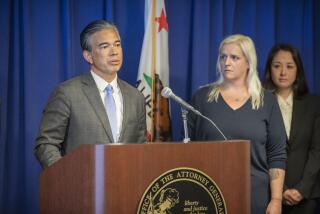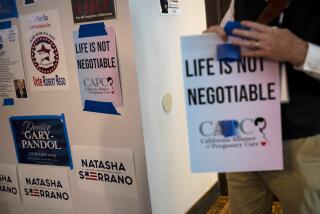Seven Target Cities Brace for Operation Rescue : Protests: Clinics and doctors from San Jose to Philadelphia will be focus of abortion foes’ onslaught. Both sides say they will apply lessons from the past.
SAN FRANCISCO — Armed with new laws, a get-tough attitude and lessons learned from battles past, seven U.S. cities are bracing for a showdown beginning today between abortion rights activists and Operation Rescue protesters targeting clinics and doctors who perform the procedure.
Launching a 10-day campaign dubbed “Cities of Refuge,” Operation Rescue is replaying the annual summer assault on abortion providers it began three years ago. But the battle plan--and goals--have changed for 1993.
Instead of targeting a single city, abortion opponents this summer will simultaneously fan out in seven metropolitan areas, from San Jose in the West to Philadelphia in the East.
And although earlier campaigns sought mainly to blockade clinics, Operation Rescue is fixing its sights on physicians and other workers who are likely to see pickets outside their kitchen windows, protesters barring their path to work and “wanted” posters bearing their names and photographs tacked up in public places.
“It is our goal to expose these abortionists right in their own neighborhoods,” said Sue Finn, an Operation Rescue spokeswoman. Already, she confirmed, letters have gone out in all seven cities, warning them to cease their activities or risk harassment.
Abortion rights activists say they will respond to the campaign with thousands of trained “clinic defenders,” guards for the homes and families of threatened physicians and escorts for women seeking treatment.
Fences have been erected by clinic operators in a few cities, windows have been bolted shut at many clinics and some doctors have taken to wearing bulletproof vests.
“Everyone has done their groundwork and is ready for whatever will come,” said Gina Shaw, manager of clinic support for the National Abortion Federation in Washington. “But these tactics create a lot of fear and stress for patients and clinic staff.”
Indeed, as Day 1 of the demonstrations drew near, San Jose’s collectively edgy mood seemed representative of emotions in the six other targeted communities. Mindful of a recent tide of abortion-related violence--capped by the March slaying of a Florida doctor--some authorities say they fear the coming days will bring ugly confrontations.
Following a national trend, the San Jose City Council--led by Mayor Susan Hammer, who campaigned on an abortion rights platform--has adopted two ordinances aimed at curbing the protests. One creates a protective, eight-foot “bubble zone” around patients seeking entry into a clinic, while the other forbids picketing within 300 feet of a target’s home.
San Jose police--recalling Operation Rescue’s 1991 siege in Wichita, Kan., that exploded beyond the control of local officers--have consulted veterans of abortion wars and undergone three months of special training for the conflict.
“The message we got from everyone was, ‘Take a strong posture right from the start, or it will overwhelm you,’ ” Assistant Chief Bill Lansdowne said. “That’s exactly what we plan to do.”
Lansdowne said 200 extra special operations officers will be on duty to patrol the protests, with hundreds of others at the ready. Officers assigned to arrest violators, he added, were hand-picked for such work.
“We looked for officers who are patient and not particularly subject to stress,” Lansdowne said. “We hope to be as low-key as possible . . . and set a (national) standard for the handling of these major demonstrations.”
Similar preparations have been underway in other targeted communities. In Philadelphia, the city council passed a law protecting access to clinics and police encircled them with metal barricades to discourage protests.
Dallas enacted a ban on residential picketing, and Cleveland officials said Ohio’s new anti-stalking law might be used against people harassing physicians and other clinic workers.
In Minnesota, Atty. Gen. Hubert H. Humphrey III--anticipating trouble in the target city of Minneapolis--sent Operation Rescue a letter, warning that physical interference with the right to obtain an abortion would not be tolerated. And an eight-foot chain link fence was erected around a Planned Parenthood clinic in a Minneapolis suburb.
The two other cities on Operation Rescue’s target list--Melbourne, Fla., and Jackson, Miss.--have not taken any unusual steps thus far. Operation Rescue chose the seven sites so every citizen would be within a 24-hour drive of one.
Operation Rescue leaders condemned laws such as those adopted in San Jose as discriminatory but said the measures would not deter protesters. “We will do what we have to do to save a child’s life, even if that means trespassing or breaking a law,” Finn said. She added that the ordinances are “definitely discriminatory” against abortion foes and are designed to “crush our pro-life movement.”
Born of a prayer meeting in Binghamton, N.Y., in 1987, Operation Rescue has evolved to become one of the most visible elements of the anti-abortion movement. Its founder, Randall Terry, was recently sentenced to five months in jail for his role in presenting a fetus to then-candidate Bill Clinton last year.
Operation Rescue’s biggest impact, most agree, was two summers ago, in a massive protest in Wichita. The “Summer of Mercy” campaign shut down three clinics for more than a week and led to 2,600 arrests. Costs to the city totaled $900,000.
In the aftermath, cities began to prepare more vigorously for the anti-abortion campaigns and new laws have hindered the group’s clinic-blockading techniques. Since Wichita, no clinic has been shut down for more than a few hours.
Operation Rescue, in turn, has shifted its focus to doctors, which Terry, in one recent interview, called “the weak link.” Many physicians besieged by picketers and other forms of harassment have obtained court injunctions against the group.
As they ready for battle, neither side in the abortion debate has revealed much about its plans--even though each camp acknowledges the deployment of spies in the opposing organization.
Operation Rescue plans to kick off “Cities of Refuge” with rallies today. On Saturday, protesters will gather at dawn to receive their daily assignments, which also will be disseminated via a 24-hour hot line. Terry plans to visit each city to motivate the troops.
Some abortion rights leaders view the summer campaign as a crucial test of Operation Rescue’s potency, which has been threatened by the election of a pro-abortion rights President, last year’s U.S. Supreme Court decision upholding basic abortion rights and the March killing of Dr. David Gunn in Pensacola, Fla., by an anti-abortion activist.
Finn, the group’s spokeswoman, disagreed, saying the group is as strong as ever.
More to Read
Sign up for Essential California
The most important California stories and recommendations in your inbox every morning.
You may occasionally receive promotional content from the Los Angeles Times.










